Poonam Verma and Jamaluddin
Department of Biological Sciences, Rani Durgavati University, Jabalpur, India.
Corresponding Author E-mail: poonamverma8624@gmail.com
Abstract
The research was aimed to observed roll of fungi and duration to change the physical composition of waste during the composting process. It’s due to breakdown of large polymer in to small molecules in the presence of fungi, which are more dominated in municipal solid waste (MSW). Aspergillus flavus, Aspergillus sp., Mucor sp., Aspergillus glaeucus, Aspergillus ustus and Unidentified sp. (1) was isolated from MSW from ranital and civil line in Jabalpur and its show the relationship with decomposition in different time interval. In composting physical parameter’s like Moisture content, pH, electrical conductivity (EC), Ash and Weight loss was increased or reduced continuously. These are show either negative or positive correlation value. Out of 6 isolates Aspergillus glaeucus and Unidentified sp. (1) was suitable option for increased soil fertility
Keywords
Correlation; Composting; Parameter; Decomposition; Awareness
Download this article as:| Copy the following to cite this article: Verma P, Jamaluddin. A Study on Correlation between Different Physical Parameters, Which are Change after Composting. Biomed Pharmacol J 2012;5(2) |
| Copy the following to cite this URL: Verma P, Jamaluddin. A Study on Correlation between Different Physical Parameters, Which are Change after Composting. Biomed Pharmacol J 2012;5(2). Available from: http://biomedpharmajournal.org/?p=2544 |
Introduction
Composting is a best alternative for reduced MSW. Composting involves the biological decomposition of organic matter under aerobic conditions to produce a humus-like product. Residues such as yard waste, manure, sewage sludge, MSW or industrial waste are recycled worldwide through field scale composting (Lasaridi et al., 2006). The recycling of the domestic organic waste through home composting is also practiced worldwide, contributing to the increased level of environmental awareness (Haruta et al., 2005). Compost products are used in agriculture, forest or ornamental farming and as landfill cover in public areas as parks or sport fields (Wei et al., 2000). Previous studies show that compost microbiota is rather complex and that the use of culture-dependent and independent methods may reveal different members of these communities (Takaku et al., 2006). Whereas fungi are the predominant culturable microbiota found in composts (Dees et al., 2001). Compost is the final product of an extensive process of biological decomposition of organic residues with increased bioavailability of nutrients and reduced pathogen presence. Microorganisms able to degrade polymers through the production of extracellular enzymes or to inhibit pathogens may have a selective advantage during the composting process. Their presence in the finished product is important, reflecting somehow the compost quality, and its properties as nutrient supplier and pathogen suppressor. The present work aimed at the comparison of different physical parameter change with the diversity of fungi isolated from municipal solid waste in Jabalpur city.
Material and method
Sample collection
Jabalpur is a one of most big city of Madhya Pradesh with population above 10 lack’s. Generated waste was dumped in open area in city and major dumping site is Ranital dumping area. The study of MSW was collected from the different garbage center of Jabalpur city.
Test of Micronutrient of MSW
Preparation of organic solid waste for bioconversion
Municipal organic wastes were collected and cut into 2-3 mm small pieces and 25gm of each was aliquotted into a 250 ml conical flask, which was then sealed with a cotton plug. The bottles containing Municipal organic waste were then autoclaved at 121°C and 15lbps pressure for 15 min (Rahman et al., 2009).
Preparation and application of culture discs
Aspergillus flavus, Aspergillus sp., Mucor sp., Aspergillus glaeucus, Aspergillus ustus and Unidentified sp. (1) which are isolated from MSW and screen out by enzymatic action of fungi. Strains were cultured on potato dextrose agar (PDA) medium at 27±2°C for 7 days. Then a culture disc (5 mm diam.) was cut with a cork borer and 6 culture discs were inoculated with autoclaved Municipal organic waste. Control treatments were performed with no inoculation. The bottles were then sealed with Para film and labelled. The entire process was completed inside a laminar flow (Rahman et al., 2009). Then give 0, 5, 10, 15 and 20 days incubation at 28 ±2 ºC.
Analysis of Physicochemical properties
Physical parameters:
Moisture content is measured by difference between initial weight and Dry weight of sample using Hot air oven. The pH and EC was measured for 1:5 ratio samples and distilled water using pH and EC Digital meter respectively. The Ash and Weight loss is determined according to using standard method (Jackson, 1973).
Result and Discussion
During the composting process, besides the final product in the form of humus, heat, compounds of nitrogen, oxygen, phosphorus, CO2, H2O; in addition, a significant amount of microorganism biomass is created (Tiquia et al., 2002). The conversion and succession different type of mesophilic and thermophilic microorganisms in composted material is connected with different physical parameters like pH, Weight loss, Moisture, Ash and EC changes and indicates the correct course of the composting process (Ishii et al., 2000). In decomposition has been the need to isolate and identify microorganism, which degrade complex organic substrate of waste into economical and environmentally substrates compose which increase soil fertility thus it can be used as a conditioner of soil.
Presence of significant amount of biodegradable organic and inorganic material in comparison of those of standard value (Gautum et al., 2010). The successful degradation depends on a number of physical factors that directly and indirectly influence on the activities of the fungi (Taiwo et al., 2004). The measurement of composting were used in the study, correlation with these measures i.e,. Weight loss, pH, Ash and EC was observed. In correlation value will be lying between +1 and -1 called positive and negative correlation respectively. The value of correlation not more than 1. At present observation for moisture give positive relation means moisture content are increased. Aspergillus glaeucus, Unidentified sp. (1) show sufficiently high degree of correlation, moderate degree by Aspergillus flavus, Aspergillus sp., Mucor sp. and Aspergillus ustus show possible no correlation. In pH observation only Aspergillus ustus and Aspergillus glaeucus was shown positive correlation and other was give negative correlation that means these was shown best result for composting because pH value change due to methanogenic activity as a result increase in methane gas production and decrease in hydrogen, carbon dioxide and volatile fatty acid production (Murphy et al., 1995). A decrease in CO2 leads to decrease in carbonic acid (H2CO3) and bicarbonate ion concentrations (HCO3) consuming H+ ions (Kim, 2005). EC of the decomposing material was maximum or minimum. Due to high initial microbial activity and mineralization, soluble salt content will be high and hence high EC in initial stages. In later stages, as humification prorganic carboneeds the humic fractions which might have complexes with the soluble salt and then decreasing amount of mobile free ions (Saviozzi et al., 1988). The EC observed total concentration of ionic solutes and is a measure of the solution’s ability to convey an electric current (Rich et al., 2008). EC in a water extract of final product did not exceed the salinity limit value of 3 μs/cm to be used in good fertilizer (Soumare, 2002). In observation only Mucor sp. and Aspergillus ustus was gave positive correlation that means it was not suitable for decomposition. Weight loss and ash of substrate was increased when incubation period was increased due to break down of large molecular weight substrates and change into small molecular weight substrate and for both all are give positive correlation.
Table 1: Correlation between different physical parameter.
| Fungus | Moisture | pH | EC | Ash | Weight Loss |
| Aspergillus sp. | 0.5315 | -0.0246 | -0.7977 | 0.0454 | 0.9703 |
| Aspergillus flavus | 0.5014 | -0.3399 | -0.8345 | 0.3788 | 0.9776 |
| Aspergillus ustus | 0.2227 | 0.7509 | 0.8031 | 0.296 | 0.9551 |
| Aspergillus
glaeucus |
0.8963 | 0.2826 | -0.5696 | 0.9325 | 0.9812 |
| Mucor sp. | 0.5632 | -0.166 | 0.9456 | 0.2332 | 0.951 |
| Unidentified sp. (1) | 0.8677 | -0.1648 | -0.761 | 0.9798 | 0.9661 |
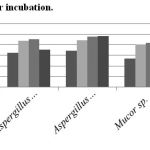 |
Figure 1: Moisture content after incubation.
|
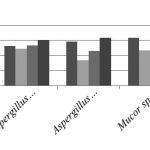 |
Figure 2: pH after incubation.
|
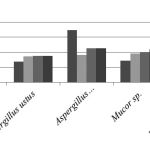 |
Figure 3: EC after incubation.
|
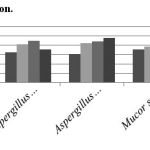 |
Figure 4: Ash content after incubation.
|
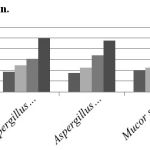 |
Figure 5: Weight loss after incubation.
|
Conclusion
Composting is one of the best methods more economical and environmentally safe for recycling waste generated by the human. The utilization of compost would be an investment in the long term for the health of soil and plant however, the composting process and quality could further be improved by addition of inoculating agent like cow manure, poultry manure and yard waste etc. Finally we can conclude that this type of recovery can be adopted country wide to recycle the organic residues as waste management option.
Acknowledgment
The authors are thankful to Head, Department of biological science, R.D.V.V. Jabalpur, for laboratory facilities.
References
- Dees, P.M., Ghiorse, W.C. Microbial diversity in hot synthetic compost as revealed by PCR-amplified rRNA sequences from cultivated isolates and extracted DNA. FEMS Microbiol Ecol., 2001; 35:207–216.
- Gautam, S.P., Bundela, S. P., Pandey, K. A., Awasthi K. M., Sarsaiya, S. Physicochemical Analysis of Municipal Solid Waste Compost. J. Appl. Sci. Res., 2010; 6(8): 1034-1039.
- Haruta, S., Nakayama, T., Nakamura, K., Hemmi, H., Ishii, M., Igarashi, Y., Nishino, T. Microbial diversity in biodegradation and reutilization processes of garbage (review). J Biosc Bioeng., 2005; 99(1): 1–11.
- Ishii, K., Fukui, M., Takii, S. Microbial succession during a composting process as evaluated by denaturing gradient gel electrophoresis analysis. Journal of Applied Microbiology., 2000; 89, 768-777.
- Jackson, M.L. Soil chemical analysis Prentice Hall of India Pvt. Ltd., 1973; New Delhi.
- Kim, H. Comparative studies of aerobic and anaerobic landfills using simulated landfill lysimeters Ph.D. Thesis, University of Florida, 2005; USA.
- Lasaridi, K., Protopapa, I., Kotsou, M., Pilidis, G., Manios, T., Kyriacou, A. Quality assessment of composts in the Greek market: the need for standards and quality assurance. J Environ Manag., 2006; 80(1):56–65
- Murphy, R.J., Jones, D.E., Stessel, R.I. Relationship of microbial mass and activity in biodegradation of solid waste. Waste Manage. Res., 1995; 13:485-497.
- Rahman, A., Begum, M. F., Rahman, M., Bari, M. A., Ilias, G.N.M. Alam, M.F. Isolation and identification of Trichoderma species from different habitats and their use for bioconversion of solid waste. Turk. J Biol., 2011; 35: 183-194.
- Rich, C., Gronow, J., Voulvoulis, N. The potential for aeration of MSW Reuse. 3rd Edn., McGraw Hill Publishing Co., New York, USA. 2008; 234-245.
- Saviozzi, A., Levi- Minzi R., Raffaldi, R. Maturity evolution of organic waste. Biocycle., 1988; 29(3); 54-56.
- Soumare, M., Demeyer, A., Tack, F.M.G., Verloo, M. G. Chemical characteristics of Malian and Belgian solid waste composts”. Bioresource and Technology., 2002; 81: 97-101.
- Taiwo, L.B., Oso, B.A. Influence of composting techniques on microbial succession, temperature and pH in a composting municipal solid waste. Afr. J. Biotechnol., 2004; 3(4): 239-243.
- Takaku, H., Kodaira, S., Kimoto, A., Nashimoto, M., Takagi, M. Microbial communities in the garbage composting with rice hull as an amendment revealed by culture-dependent and independent approaches. J Biosci Bioeng., 2006;101:42–50.
- Tiquia, S.M., Wan, J.H.C., Tam, N.F.Y. Dynamice of yard trimmings as determined by dehydrogenase activity, ATP kontent, arginine ammonification and nitrification potential. Process Biochemistry., 2002; 37, 1057-1065.
- Wei, Y., Fan, Y., Wang, M., Wang, J. Composting and compost application in China. Resour Conserv Recycl., 2000; 30: 277–300.







